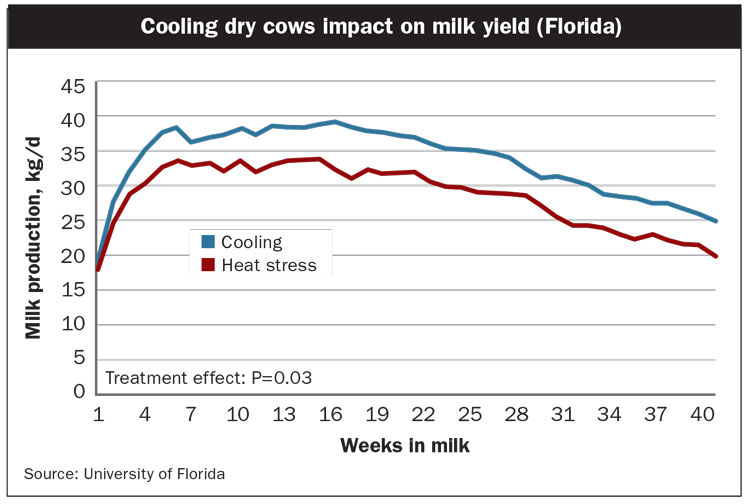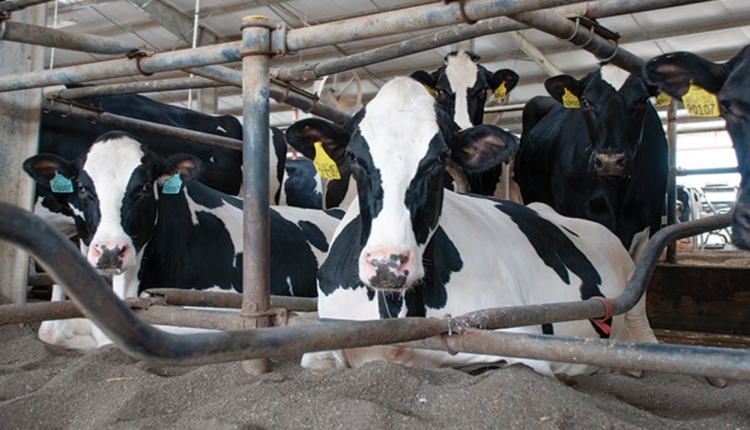The author is a professor emeritus of animal sciences at the University of Illinois, Urbana.
Even before heat stress affects people, dairy cattle around the globe feel the negative impacts during hot weather seasons much sooner. In fact, mild heat stress starts around 72°F with 50% humidity. High-producing cows eat more and generate more heat. In these situations, high-performing cows can begin to experience heat stress in well-ventilated barns at air temperatures as low as 65°F.
Ohio State University researchers report the economic loss in the U.S. can reach $1.6 billion annually. Meanwhile, University of Wisconsin workers measured the cost of heat stress at $74 per cow based on milk yield losses. Keep in mind that Wisconsin has lower heat stress compared to states like Texas or those in the Southeast such as Florida and Georgia.
In general, heat stress can be defined as an event in which cows require additional nutrients to reduce heat load or stress on the cow, including energy, glucose, amino acids, and essential fatty acids to maintain cell membranes, reduce inflammation effects, and aid fertility. One measurement is to calculate the temperature-humidity index (THI). A THI formula is averaging the temperature in degrees Fahrenheit (°F) plus humidity percent divided by two.
For example, if the temperature was 80°F with 70% humidity, this results in a THI of 75. When the THI is over the 68 threshold, heat abatement is necessary to minimize its impact (facilities, management, and diet). The issue, however, is that dairy managers often do not personally experience heat stress at THI 68. This situation often delays important abatement changes.
Remember, it’s the combination of heat and humidity that significantly amplify heat stress. When both temperatures and humidity are high, water vapor cannot dissipate and that causes heat stress conditions to linger for longer periods further stressing cows.
Cow responses
As core body temperature climbs, fertility suffers, maintenance requirements rise, and dry matter intake declines (see table). Greater blood circulation flows to the exterior of the cow’s body to dissipate heat to the greater environment. This reduces blood flow to the rumen and uterus.

Panting and rapid breathing often takes place to help with heat loss. However, the physiological situation changes blood carbon dioxide and blood hydrogen carbonate, impacting blood chemistry.
Cows will stand and/or perch in freestalls to expose more body surface area for cooling, which reduces cow comfort and potentially elevates lameness.
Inflammation often becomes an issue and leads to leaky gut and health challenges. Inflammation also raises glucose requirements, estimated to be 2 pounds per 12 hours by Iowa State University workers.
The visible signs
Dairy cows exhibit higher respiratory rates (over 60 breaths per minute); drooling, leading to lower rumination and loss of saliva needed for buffering the rumen; and less lying time and perching in freestalls. In addition, a 1°F to 2°F rise in body temperature reduces embryo survival in the uterus and lowers dry matter intake.
Milk components also may decline due to lower rumen production of bacterial amino acids and acetic acid (a rumen volatile fatty acid and source of de nova synthesis of milkfat).
Monitoring milk urea nitrogen (MUN) reveals if the rumen microbes are converting rumen ammonia to bacterial amino acids. If MUN values climb more than 2 milligrams per deciliter (mg/dl), heat stress can also be reflected in limitations in the rumen environment via pH and bacteria shifts.
Feeding considerations
Dry matter intake can drop due to the added heat of fermentation from feed digestion in the rumen. Eating patterns shift to avoid this added heat increment during heat stress. Heat stress effects often peak during the hotter times of the day, typically 8 a.m. to 8 p.m. or sunup to sundown. In addition, rate of feed passage may slow due to shifts in rumen fermentation, bacteria changes, and less blood flow to the rumen.
To maintain nutrient requirements related to high-maintenance needs and lower feed intake, consider the following points:
- Boost the diet’s palatability by feeding silages containing lactic and acetic acid, which stabilizes the bunk and avoids secondary fermentation. Liquid molasses also can improve palatability and lower sorting risks.
- Replace low-quality forages that often cause higher rumen heat increment with feed ingredients and/or by-product feeds with higher neutral detergent fiber (NDF) digestibility and starch while avoiding rumen acidosis. These forages can include BMR corn silage, lower lignin alfalfa, soy hulls, beet pulp, citrus pulp, or corn gluten feed.
- Added fats and oils contain higher levels of energy per pound of dry matter and do not contribute to higher heat increment. Rumen protected essential fatty acids may improve cell membrane function and lower inflammation.
- Balance the rumen degradable protein (RDP) and rumen undegraded protein (RUP) to avoid excess nitrogen that requires energy to convert to blood urea and be excreted in urine and milk as MUN.
Evaluate feedbunk management when considering and implementing this list of changes. Check feed stability over the day to avoid secondary fermentation heating and mold formation. Commercial propionic and acetic acid blends can be added to avoid wild yeast and mold growth. Feeding diets during cooler time periods such as the evening and early morning can stimulate higher feed intake. Consider feeding more frequently, providing a fresh diet, encouraging dry matter intake, and doing timely pushups.
Additive options
Using feed additives can improve dry matter intake, stabilize rumen fermentation, reduce inflammation, and maintain fertility. Consider the cost versus expected responses when selecting feed additives.
Sodium bicarbonate and potassium carbonate can effectively elevate the dietary cation-anion difference (DCAD) up to greater than +300 milliequivalents per kilogram of dry matter. Under heat stress, dairy cows lose sodium and potassium needed as electrolytes. Both additives also buffer the rumen and stabilize rumen pH. Salt and potassium chloride do not increase the diet DCAD levels.
An ionophore can improve propionate (rumen volatile fatty acids or VFA) leading to higher levels of glucose through liver conversions. Glucose is needed for inflammation requirements. Ionophores also reduce rumen lactic acid production. Lactic acid lowers rumen pH.
Yeast products can stabilize rumen pH; improve fiber digestion, leading to higher levels of acetic acid needed for milkfat synthesis; and lower lactic acid levels in the rumen. Yeast cell walls also can improve lower gut health and reduce mycotoxin levels.

Rumen-protected niacin can improve blood flow to the skin, enhancing heat dissipation, which in turn lowers body temperature based on Arizona data.
Rumen-protected chromium can stimulate glucose synthesis and improve insulin sensitivity.
Effects on dry cows
The University of Florida has conducted studies on cooling dry cows as shown in the graph. They reported higher milk yield after calving, full weight calves at birth, higher levels of colostrum antibodies, and higher average daily gain in young calves.
Another impact is epigenetics, which reflected that the cooled dry cows’ heifer calves produced 4 pounds more milk two years later when calving as first-lactation cows. Cooling during the entire dry period is recommended, especially for close-up cows (last 21 days before calving).
Heat stress in young calves
Recent studies indicate that calves housed in calf hutches exposed to the sun should be shaded with a shade cloth or with trees. Some newer-style calf hutches have a door in the back of the hutch to allow air movement and ventilation.
It’s best to orientate calf hutches away from direct sunlight at the front of the hutch. Another approach is to place blocks to elevate the hutch, allowing air movement from the base. Availability of fresh and clean water is important, too.


